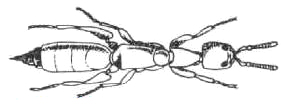|
Sclerodermus Domesticus
''Sclerodermus domesticus'', also known as ''Scleroderma domesticus'', ''Scleroderma domesticum'', ''Scleroderma domestica'' or "antiquarian's friend", is a species of cuckoo wasp in the insect genus ''Sclerodermus''. It was first described by Pierre André Latreille in 1809. Description ''Sclerodermus domesticus'' preys on Coleoptera including ''Anobium punctatum'', ''Stegobium paniceum'', ''Lasioderma serricorne'', ''Hylotrupes bajulus'' and ''Nicobium castaneum'', or occasionally Lepidoptera. Males have wings but lack a stinger. Females are 2–5 mm long; they have a stinger but lack wings. They are black/brown, and have the appearance of ants. Females enter woodworm holes, paralyze the woodworm larvae with the venom of the stinger and lay their eggs in the corpses, which form the food for the ''S. domesticus'' larvae. This behavior leads to the common name of "antiquarian's friend". Distribution and habitat ''S. domesticus'' is a cosmopolitan species. It prefers mild ... [...More Info...] [...Related Items...] OR: [Wikipedia] [Google] [Baidu] |
Cuckoo Wasp
Commonly known as cuckoo wasps or emerald wasps, the hymenopteran family Chrysididae is a very large cosmopolitan group (over 3000 described species) of parasitoid or kleptoparasitic wasps, often highly sculptured, with brilliant metallic colors created by structural coloration. They are most diverse in desert regions of the world, as they are typically associated with solitary bee and wasp species, which are also most diverse in such areas. Their brood parasitic lifestyle has led to the evolution of fascinating adaptations, including chemical mimicry of host odors by some species. Nomenclature The term "cuckoo wasp" refers to the cuckoo-like way in which wasps in the family lay eggs in the nests of unrelated host species. The term is also used for some wasps outside of the family, such as '' Sapyga louisi''. Chrysididae, the scientific name of the family, refers to their shiny bodies and is derived from Greek ''chrysis, chrysid-'', "gold vessel, gold-embroidered dress", plus ... [...More Info...] [...Related Items...] OR: [Wikipedia] [Google] [Baidu] |

